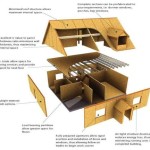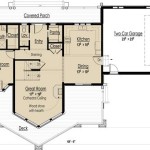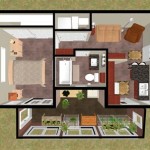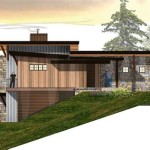Open concept house floor plans feature large, interconnected living spaces that flow into one another without any enclosed or separated rooms. This architectural style emphasizes a sense of openness, natural light, and fluidity. One example of an open concept floor plan is a home where the kitchen, dining room, and living room are all connected in one spacious area.
Open concept houses have gained popularity in recent years due to their modern aesthetic and practical benefits. They create a more vibrant and social atmosphere by allowing multiple family members or guests to interact and participate in different activities in the same space.
In the following sections, we will delve deeper into the advantages and considerations of open concept house floor plans, exploring their impact on space utilization, natural light, and the overall living experience.
Open concept house floor plans offer numerous advantages, making them a popular choice for modern homeowners. Here are 10 key points to consider:
- Increased natural light
- Improved space utilization
- Enhanced social interaction
- Greater sense of openness
- Improved air circulation
- Easier supervision of children
- Reduced noise levels
- Cost-effectiveness
- Modern aesthetic appeal
- Flexibility and adaptability
Keep in mind that while open concept floor plans provide many benefits, they may not be suitable for all homeowners. It is important to carefully consider your lifestyle and preferences before deciding if an open concept home is the right choice for you.
Increased natural light
Open concept house floor plans are designed to maximize natural light by eliminating walls and other obstructions that can block sunlight. This creates a brighter, more inviting living space that can reduce the need for artificial lighting during the day. Large windows and sliding glass doors allow for ample sunlight to enter the home, creating a connection to the outdoors and providing stunning views.
The absence of walls and enclosed rooms allows natural light to flow freely throughout the entire space, eliminating dark corners and creating a more uniform distribution of light. This can be particularly beneficial in areas with limited natural light, such as homes nestled in dense neighborhoods or surrounded by tall trees. By embracing an open concept design, homeowners can enjoy a brighter, more cheerful living environment that promotes well-being and reduces the need for energy consumption.
In addition to enhancing the overall ambiance of the home, increased natural light has numerous health benefits. Studies have shown that exposure to sunlight can improve mood, boost cognitive function, and regulate circadian rhythms. Natural light can also help reduce the risk of certain health conditions, such as seasonal affective disorder (SAD) and vitamin D deficiency. By incorporating an open concept floor plan into their homes, homeowners can create a living space that not only looks great but also promotes their physical and mental well-being.
The increased natural light provided by open concept floor plans can also have a positive impact on energy efficiency. By reducing the need for artificial lighting during the day, homeowners can lower their energy consumption and save money on utility bills. This makes open concept homes not only stylish and comfortable but also environmentally friendly and cost-effective.
Improved space utilization
Open concept house floor plans are renowned for their ability to maximize space utilization by eliminating unnecessary walls and barriers. This creates a more spacious and fluid living environment that can accommodate multiple functions and activities within a single open area.
- Elimination of wasted space
Traditional floor plans often have separate rooms for specific purposes, such as a living room, dining room, and family room. These dedicated rooms can lead to wasted space, especially in smaller homes or apartments. Open concept floor plans combine these functions into one large, open area, eliminating the need for separate rooms and maximizing the usable space.
- Multi-functional spaces
The open and flexible nature of open concept floor plans allows for multi-functional spaces that can adapt to changing needs and preferences. For example, a large open area can be used for entertaining guests, relaxing with family, or even as a home office. This versatility makes open concept homes ideal for families with varying lifestyles and space requirements.
- Improved flow and accessibility
Open concept floor plans create a smooth and seamless flow between different areas of the home. Without walls or doors obstructing movement, individuals can easily move from one space to another, fostering a sense of connection and accessibility. This is particularly beneficial for families with young children or individuals with mobility impairments.
- Increased storage options
Despite the absence of walls, open concept floor plans offer ample opportunities for storage. Strategic placement of built-in shelves, cabinets, and drawers can provide ample storage space without compromising the open and airy feel of the home. Additionally, the use of vertical space, such as tall bookcases or floating shelves, can further enhance storage capacity.
By maximizing space utilization, open concept house floor plans create a more spacious, flexible, and functional living environment that meets the evolving needs of modern homeowners.
Enhanced social interaction
Open concept house floor plans are designed to foster a strong sense of community and togetherness by promoting social interaction among family members and guests.
- Elimination of barriers
Traditional floor plans often have separate rooms for different activities, creating physical barriers that can hinder social interaction. Open concept floor plans eliminate these barriers by combining multiple functions into one large, open area. This allows family members and guests to easily interact with each other, regardless of their location within the space.
- Improved sightlines
The open and unobstructed nature of open concept floor plans provides clear sightlines throughout the space. This allows individuals to maintain visual contact with each other, even when they are engaged in different activities. Improved sightlines encourage casual conversations, spontaneous interactions, and a stronger sense of connection among occupants.
- Central gathering spaces
Open concept floor plans often feature central gathering spaces, such as a large living area or kitchen island, that serve as natural focal points for social interaction. These spaces provide a comfortable and inviting environment for family and friends to come together, share stories, and create lasting memories.
- Enhanced communication
The open and airy nature of open concept floor plans facilitates effortless communication between individuals. Sound travels more easily throughout the space, allowing family members to stay connected even when they are in different areas of the home. This improved communication fosters a sense of unity and makes it easier for family members to stay informed about each other’s activities and needs.
By eliminating barriers, improving sightlines, creating central gathering spaces, and enhancing communication, open concept house floor plans promote social interaction and create a more cohesive and connected living environment.
Greater sense of openness
Open concept house floor plans are designed to create a greater sense of openness and spaciousness by eliminating walls and other physical barriers that can make a home feel cramped and confining. This open and airy design allows for a more expansive and inviting living environment that promotes a feeling of freedom and well-being.
The absence of walls and enclosed rooms allows for a seamless flow of movement and natural light throughout the space. This creates a more cohesive and visually appealing environment that encourages individuals to move around and interact with each other more freely. The open and unobstructed layout promotes a sense of connection and togetherness, making it easier for family members and guests to engage in activities and conversations.
Furthermore, open concept floor plans often feature large windows and sliding glass doors that connect the interior living space to the outdoors. This integration of indoor and outdoor areas further enhances the sense of openness and brings the beauty of nature into the home. By blurring the boundaries between the inside and outside, open concept homes create a more spacious and inviting living environment that promotes a connection to the surrounding landscape.
The greater sense of openness provided by open concept house floor plans has numerous benefits for homeowners. It can reduce stress levels, improve mood, and boost creativity. Open and airy spaces have been shown to promote better sleep, enhance cognitive function, and increase productivity. By incorporating an open concept design into their homes, homeowners can create a more spacious, inviting, and healthy living environment that supports their overall well-being.
Improved air circulation
Open concept house floor plans promote improved air circulation by eliminating enclosed spaces and allowing air to flow freely throughout the entire home. This has numerous benefits for indoor air quality and the health and well-being of occupants.
- Reduced stagnation
Traditional floor plans with separate rooms can lead to air stagnation, especially in areas with poor ventilation. Open concept floor plans, on the other hand, allow air to circulate more easily, preventing the buildup of stale air and reducing the risk of indoor air pollution.
- Increased ventilation
Open concept homes often feature large windows and sliding glass doors that allow for ample ventilation. This natural ventilation helps to bring in fresh air from the outdoors and expel stale air, creating a healthier and more comfortable living environment.
- Improved distribution of heating and cooling
The open and interconnected nature of open concept floor plans allows for more efficient distribution of heating and cooling throughout the home. This eliminates hot or cold spots and ensures a more comfortable temperature in all areas of the house.
- Reduced moisture and condensation
Improved air circulation helps to reduce moisture and condensation levels within the home. This is particularly beneficial in areas prone to mold and mildew growth, such as bathrooms and kitchens. By allowing air to circulate freely, open concept floor plans help to prevent the buildup of moisture and create a healthier indoor environment.
Overall, the improved air circulation provided by open concept house floor plans contributes to a healthier and more comfortable living environment. By reducing air stagnation, increasing ventilation, distributing heating and cooling more efficiently, and reducing moisture and condensation, open concept homes promote better indoor air quality and support the well-being of occupants.
Easier supervision of children
Open concept house floor plans are particularly advantageous for families with young children as they offer increased visibility and easier supervision.
- Unobstructed sightlines
The open and interconnected nature of open concept floor plans provides clear sightlines throughout the main living areas. This allows parents to easily keep an eye on their children while they play, regardless of where they are in the space. Unobstructed sightlines promote peace of mind and make it easier for parents to respond quickly to any needs or emergencies.
- Centralized play areas
Open concept floor plans often feature central gathering spaces, such as a large living area or kitchen island, that naturally become the focal point for family activities. By creating designated play areas within these central spaces, parents can easily supervise their children while also participating in other activities, such as cooking, cleaning, or entertaining guests.
- Reduced risk of accidents
The open and clutter-free nature of open concept floor plans helps to reduce the risk of accidents and injuries. With fewer obstacles and tripping hazards, children can move around more freely and safely. Parents can also easily monitor their children’s activities and intervene if necessary, preventing potential accidents.
- Enhanced communication
The open and airy nature of open concept floor plans facilitates effortless communication between parents and children. Sound travels more easily throughout the space, allowing parents to stay connected with their children even when they are in different areas of the home. This enhanced communication makes it easier for parents to provide guidance, support, and reassurance to their children, fostering a stronger parent-child bond.
Overall, the easier supervision of children provided by open concept house floor plans offers peace of mind to parents and creates a safer and more nurturing environment for children to grow and thrive.
Reduced noise levels
Open concept house floor plans offer reduced noise levels compared to traditional floor plans with separate rooms. The absence of enclosed spaces and the presence of sound-absorbing materials, such as rugs and upholstered furniture, contribute to a quieter and more peaceful living environment.
By eliminating walls and doors, open concept floor plans allow sound to dissipate more evenly throughout the home. This prevents sound from becoming trapped in specific rooms and reduces the overall noise level. Open and interconnected spaces promote a more consistent acoustic environment, making it easier for individuals to hear and communicate with each other.
Furthermore, open concept floor plans often incorporate sound-dampening materials and design elements to further reduce noise levels. Soft furnishings, such as rugs, curtains, and upholstered furniture, absorb sound waves and minimize echoes. Additionally, the use of sound-absorbing panels or acoustic tiles on walls and ceilings can help to reduce reverberation and create a more tranquil atmosphere.
Reduced noise levels in open concept house floor plans provide numerous benefits for occupants. A quieter living environment can promote relaxation, improve sleep quality, and enhance concentration. It can also reduce stress levels and create a more peaceful and harmonious atmosphere for families and individuals alike.
Overall, the reduced noise levels offered by open concept house floor plans contribute to a more comfortable, serene, and enjoyable living experience.
Cost-effectiveness
Open concept house floor plans offer cost-effective advantages compared to traditional floor plans with separate rooms. The elimination of walls and the efficient use of space can lead to significant savings in construction and maintenance costs.
- Reduced construction costs
Open concept floor plans require fewer walls and building materials, resulting in lower construction costs. By eliminating unnecessary walls and hallways, builders can save on materials, labor, and time, making open concept homes more affordable to build.
- Efficient use of space
Open concept floor plans maximize space utilization by eliminating wasted space in hallways and enclosed rooms. This allows homeowners to build smaller homes without sacrificing functionality or comfort, leading to potential savings in construction and property taxes.
- Lower energy costs
Open concept floor plans promote better air circulation and natural light distribution, reducing the need for artificial lighting and heating/cooling systems. This can result in lower energy consumption and utility bills, providing ongoing cost savings for homeowners.
- Simplified maintenance
Open concept floor plans are easier to clean and maintain due to their fewer surfaces and open sightlines. This can save homeowners time and money on cleaning supplies and professional cleaning services.
Overall, the cost-effectiveness of open concept house floor plans makes them an attractive option for homeowners looking to build or remodel their homes in a budget-friendly and efficient manner.
Modern aesthetic appeal
Open concept house floor plans have gained immense popularity in recent years due to their modern aesthetic appeal. The absence of walls and the seamless flow of space create a sleek, minimalist, and contemporary look that is highly sought after by homeowners.
Open concept floor plans emphasize clean lines, simplicity, and an abundance of natural light. The open and airy design allows for a more spacious and inviting living environment that is perfect for modern lifestyles. Large windows and sliding glass doors connect the interior with the outdoors, blurring the boundaries between indoor and outdoor spaces and bringing the beauty of nature into the home.
The modern aesthetic of open concept floor plans is further enhanced by the use of contemporary materials and finishes. Polished concrete floors, exposed brick walls, and sleek cabinetry create a sophisticated and stylish look that is both functional and visually appealing. Open concept homes often incorporate smart home technology and energy-efficient features, reflecting the modern homeowner’s desire for convenience and sustainability.
Overall, the modern aesthetic appeal of open concept house floor plans makes them an ideal choice for homeowners who value a contemporary and sophisticated living environment. The open and airy design, combined with modern materials and finishes, creates a stylish and inviting space that is perfect for entertaining, relaxing, and enjoying the beauty of the outdoors.
In addition to their modern aesthetic appeal, open concept floor plans offer numerous other advantages, including improved space utilization, enhanced social interaction, greater sense of openness, and reduced noise levels. These benefits make open concept homes not only stylish but also functional and comfortable for modern families.
Flexibility and adaptability
Open concept house floor plans offer a high degree of flexibility and adaptability, allowing homeowners to customize and reconfigure their living spaces to meet their changing needs and preferences. The absence of walls and the open and fluid layout provide ample opportunities for creative space planning and functional arrangements.
One of the key advantages of open concept floor plans is the ability to easily modify the layout of the space. Furniture and room dividers can be used to create separate areas for different activities, such as living, dining, and working. This flexibility allows homeowners to adapt their homes to their evolving lifestyles, whether it’s accommodating a growing family, pursuing new hobbies, or simply seeking a change of scenery.
Furthermore, open concept floor plans are highly adaptable to different architectural styles and personal tastes. They can be seamlessly integrated with various design elements, from traditional to contemporary, and can be customized to reflect the unique personality and style of the homeowners. Whether it’s exposed beams and rustic finishes or modern artwork and sleek furnishings, open concept homes provide a versatile canvas for self-expression and creativity.
The flexibility and adaptability of open concept house floor plans extend to future renovations and expansions as well. The open and interconnected nature of the space makes it easier to add new rooms or extend existing ones without major structural changes. This adaptability ensures that open concept homes can grow and evolve alongside the needs of the homeowners, providing a long-term and sustainable living solution.
Overall, the flexibility and adaptability of open concept house floor plans empower homeowners to create dynamic and versatile living spaces that can adapt to their changing needs and preferences. The ability to easily modify the layout, integrate different design styles, and accommodate future renovations makes open concept homes a smart and sustainable choice for modern homeowners.










Related Posts








